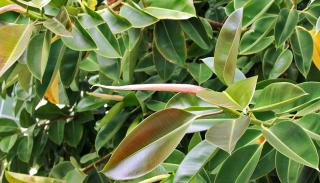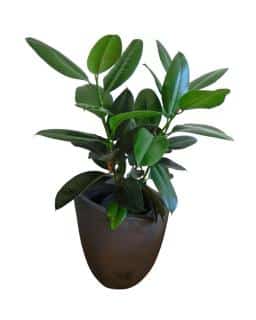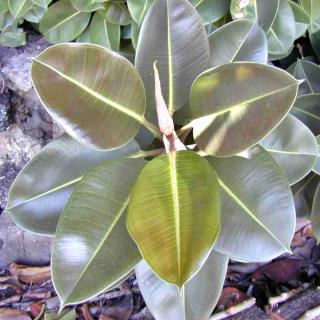

The rubber tree, or Ficus elastica, is a very beautiful indoor plant much liked for its shiny thick leathery leaves.
Ficus elastica facts :
Name – Ficus elastica
Family – Moraceae (mulberry family)
Type – indoor plant
Height – 10 feet (3 meters) indoors
Soil – indoor plant soil mix
Exposure – abundant indirect light
Foliage – evergreen
Of course, when rubber is mentioned most people think of latex, but we’re all the wiser in knowing that it is a marvelous indoor plant.
This tropical plant abhors dry air. It must be provided with as much air moisture as is possible to compensate this lack.
 It must be set in a luminous room but cannot be exposed to sunlight.
It must be set in a luminous room but cannot be exposed to sunlight.Aside from regularly misting the leaves themselves, the rubber tree pot can be laid on a 1 inch (3 cm) bed of clay pebbles that will be doused with water from time to time, so that evaporation can bring moisture up to the leaves.
Quite common for rubber trees, this is normal as long as leaf loss is regular and not too many are falling.
But in case of stronger leaf fall, first check that it is correctly watered.
It should quickly bounce back more vigorous than ever.
This is often caused by red spider mites.
This is usually due to mealybugs or scale insects to which the rubber tree is very vulnerable.
The Ficus tree is a tropical plant that needs water but is vulnerable to having too much of it.

Oppositely, in winter, you may space the watering somewhat.
Feel free however to mist the leaves on a regular basis, this will increase leafage quality. It’ll also keep the leaves from drying up, especially in winter when the heating runs at full blast.
No pruning is required, although Ficus elastica copes with pruning very well.
 If you prune your rubber tree often, you’ll be helping it to branch out.
If you prune your rubber tree often, you’ll be helping it to branch out.The rubber tree is a tree from the Moraceae (mulberry) family that can grow up to 130 feet (40 meters) tall when in the wild, but rest assured, it won’t top 10 feet (3 meters) as an indoor plant.
It’s called the “Rubber plant” because it’s possible to make rubber from its latex. Latex is a milky-white substance that flows out to protect the plant when it’s wounded or broken. It’s different from sap which carries nutrients. It helps the plant heal and protect the wound.
The term Ficus means fig and there are over 1000 different species that have evolved into different shapes, some of them shrubs, some of them trees, and others closer even to vines.
In the Western world, about two dozen varieties are available for sale for indoor use, and the most common and famous of these is Ficus benjamina. Another common one is Ficus retusa, often grown as a small bonsai.
Read also:
Take note that the rubber tree leaves are toxic when ingested, and they provoke irritations, including for animals like cats and dogs.
Image credits (edits: Gaspard Lorthiois):
© CC BY-SA 2.0: Margaret Shear
Pixabay: Ирина Кудрявцева
Thank you for the detailed information on the plant. I have a small rubber plant. had 5 leaves since one year. I overwatered my plant and 2 of its leaves started turning black from the tips. I have now stopped watering it and waiting for it to bounce back. Reading your article I am hopeful, it will bounce back. Thank you.
Hi Pragya, rubber plant is also a favorite. Overwatering is common, the plant doesn’t like it much and leaves would tend to turn yellow and fall. There is a very slight chance that perhaps the water used for watering contains too many additives, this happens with tap water. Fluoride, chlorine, etc are useful for people who drink it or to keep the water safe, but for plants it isn’t that good. The absolute best is to collect rainwater and use that for watering, especially for indoor plants.